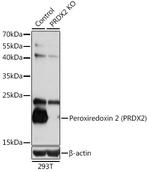Search Thermo Fisher Scientific
图: 1 / 1
PRDX2 Antibody (PA5-95989) in WB

产品信息
PA5-95989
种属反应
宿主/亚型
分类
类型
抗原
偶联物
形式
浓度
纯化类型
保存液
内含物
保存条件
运输条件
RRID
产品详细信息
Immunogen sequence: MASGNARIGK PAPDFKATAV VDGAFKEVKL SDYKGKYVVL FFYPLDFTFV CPTEIIAFSN RAEDFRKLGC EVLGVSVDSQ FTHLAWYEQG PKREVAAKLT PSGPSSVASW PLLNLWNLRF PIVKIMETLP PKSLRMMTVI SI; Positive Samples: SW480, 22Rv1, HepG2, K-562, BT-474, Mouse brain, Mouse kidney; Cellular Location: Cytoplasm
靶标信息
Peroxiredoxin (Prx) is a growing peroxidase family, whose mammalian members have been known to connect with cell proliferation, differentiation, and apoptosis. Many isoforms (about 50 proteins), collected in accordance to the amino acid sequence homology, particularly amino-terminal region containing active site cysteine residue, and the thiol-specific antioxidant activity, distribute throughout all the kingdoms. Among them, mammalian Prx consists of 6 different members grouped into typical 2-Cys, atypical 2-Cys Prx, and 1-Cys Prx. Except Prx VI belonging to 1-Cys Prx subgroup, the other five 2-Cys Prx isotypes have the thioredoxin-dependent peroxidase (TPx) activity utilizing thioredoxin, thioredoxin reductase, and NADPH as a reducing system. Mammalian Prxs are 20 - 30 kilodalton in molecular size and vary in subcellular localization: Prx I, II, and VI in cytosol, Prx III in mitochondria, Prx IV in ER and secretion, Prx V showing complicated distribution including peroxisome, mitochondria and cytosol.
仅用于科研。不用于诊断过程。未经明确授权不得转售。
篇参考文献 (0)
生物信息学
蛋白别名: Calpromotin; epididymis secretory sperm binding protein Li 2a; HGNC:9353; MGC4104; Natural killer cell-enhancing factor B; NKEF-B; Peroxiredoxin-2; protector protein; PRP; Prx II-1; thiol specific antioxidant protein; thiol-specific antioxidant 1; Thiol-specific antioxidant protein; thioredoxin dependent peroxide reductase 1; Thioredoxin peroxidase 1; thioredoxin reductase; Thioredoxin-dependent peroxide reductase 1; Thioredoxin-dependent peroxiredoxin 2; torin; Trx dependent peroxide reductase 1; TSA
基因别名: AL022839; Band-8; HEL-S-2a; NKEF-B; NKEFB; PRDX2; PRP; PRX2; PRXII; PTX1; TDPX1; TDX1; Torin; TPx; TPx-B; TPX1; TR; TSA
UniProt ID: (Human) P32119, (Mouse) Q61171, (Rat) P35704
Entrez Gene ID: (Human) 7001, (Mouse) 21672, (Rat) 29338



